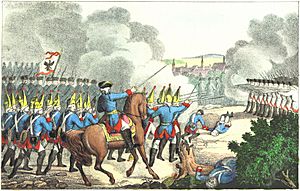Battle of Freiberg facts for kids
Quick facts for kids Battle of Freiberg |
|||||||
|---|---|---|---|---|---|---|---|
| Part of the Third Silesian War (Seven Years' War) | |||||||
 Battle of Freiberg, 29 October, 1762 |
|||||||
|
|||||||
| Belligerents | |||||||
| Commanders and leaders | |||||||
| Prince Henry of Prussia | Prince Stolberg András Hadik |
||||||
| Strength | |||||||
| 22,000 - 22,657 | 27,000 - 31,000 | ||||||
| Casualties and losses | |||||||
| 2,500 | 8,000 | ||||||
The Battle of Freiberg was a big fight that happened on October 29, 1762. It was the very last major battle of the Third Silesian War. This war was also part of an even bigger conflict called the Seven Years' War.
Why the Battle Happened
Prince Henry of Prussia was the younger brother of King Frederick II of Prussia. He led an army that wasn't made of the best soldiers. Many were 'second line' troops or 'free battalions,' which meant they were not the main fighting force.
Prince Henry decided to attack the enemy. The enemy was the Reichsarmy, led by Prince Stolberg. They also had help from Austrian soldiers under András Hadik. The allied forces were dug in on high ground west of Freiberg town. This strong position blocked the way to Dresden. Behind them was the River Mulde, with bridges to the east.
On October 28, Prince Henry and his team checked out the enemy's positions. Austrian light troops in the woods made this difficult. But Henry learned enough to understand the enemy's setup.
He saw that the main Austrian force was safe on the hills southwest of Freiberg. The Reichsarmy held the hills blocking the western path. The front of their position was strong with redoubts (small forts) and abbatis (fallen trees blocking the way). But the right side of the allied army seemed unprotected. This left the Reichsarmy troops exposed.
Prince Henry saw a chance to win. He planned to keep the Austrians busy with a small group of his soldiers. Meanwhile, his main army would go around the side and defeat the Reichsarmy, who were not as strong. Henry hoped the Austrian soldiers would stay in their safe spots and not help their allies.
The Battle Begins
At dawn on October 29, Prince Henry's army got ready. They were west of Lang Hennersdorf. He sent different groups to different places. Forcade was in the north, Kleist in the south to keep the Austrians busy. Seydlitz and Stutterheim were to attack the hills held by the Reichsarmy.
As the Prussians moved forward, they had a small fight with some Croatian soldiers in the woods. But these enemy troops soon left. Young Stutterheim's attack, however, met strong resistance. The enemy soldiers fought hard, and the Prussian attack stopped for a bit. Several Prussian cavalry (soldiers on horseback) attacks also failed. A regiment had to be moved to help stabilize this part of the fight.
While the main Prussian army attacked, Seydlitz found the ground tough for his cavalry. So, he took charge of the foot soldiers on his side. He attacked the enemy's side. The pressure grew, and Prince Stolberg began to move his soldiers south. He wanted to make the defense of a hill called Trois Croix stronger. Prince Henry also knew this hill was important. He quickly sent his grenadiers (special soldiers) towards it.
The enemy cavalry charged the Prussians. They were pushed back, but they bought time. This allowed the Reichsarmy grenadiers to take control of the hill.
Old Stutterheim noticed the Reichsarmy moving south. He realized the defenders in front of him were now weaker. He ordered his troops to attack right away. The Austrian foot soldiers began to break apart. The Prussian Belling Hussars and the Cuirassier Regiment 4 charged through the enemy. The enemy soldiers ran away and were defeated by the Prussians.
With his allies retreating and his sides open, Prince Stolberg ordered a full retreat. The Reichsarmy left their positions. The remaining Austrian troops followed them. As Prince Henry had guessed, the Austrian soldiers who were supposed to stay put did not move to help. Their commander later said he was just following orders to hold his position. The Prussians lost about 1,400 men. The allies lost about 7,000 men, 9 flags, and 28 cannons.
What Happened Next
The allied forces retreated all the way back to Pirna. The Prussians followed carefully at first, then more boldly. In early November, Kleist was sent to raid Austrian supply areas in Saxony. He destroyed them completely. Then, he took his tired soldiers into Franconia. Prince Henry had ordered him to bother the Imperialists (the enemy).
Naumberg, Würzburg, and Regensburg were taken. The ruling princes there had to pay 'contributions' (money or supplies). Prince Stolberg begged Hadik to let him go back and protect his homeland. But Stolberg did not know that Hadik had been secretly talking with King Frederick. They made a deal that led to the Reichsarmy being disbanded (broken up).

